
South Dakota is a U.S. state in the North Central region of the United States. It is also part of the Great Plains. South Dakota is named after the Dakota Sioux tribe, which comprises a large portion of the population with nine reservations currently in the state and has historically dominated the territory. South Dakota is the 17th largest by area, but the 5th least populous, and the 5th least densely populated of the 50 United States. Pierre is the state capital, and Sioux Falls, with a population of about 213,900, is South Dakota's most populous city. The state is bisected by the Missouri River, dividing South Dakota into two geographically and socially distinct halves, known to residents as "East River" and "West River". South Dakota is bordered by the states of North Dakota, Minnesota, Iowa, Nebraska, Wyoming, and Montana.

Minnehaha County is a county on the eastern border of the state of South Dakota. As of the 2020 census, the population was 197,214, making it the state's most populous county. It contains over 20% of the state's population. Its county seat is Sioux Falls, South Dakota's most populous city. The county was created in 1862 and organized in 1868. Its name was derived from the Sioux word Mnihaha, meaning "rapid water," or "waterfall".

Sioux Falls is the most populous city in the U.S. state of South Dakota and the 121st-most populous city in the United States. It is the county seat of Minnehaha County and also extends into northern Lincoln County to the south, which continues up to the Iowa state line. The population was 192,517 at the 2020 census, and in 2022, its estimated population was 202,078. According to city officials, the estimated population had grown to 213,891 as of early 2024. The Sioux Falls metro area accounts for more than 30% of the state's population. Chartered in 1856 on the banks of the Big Sioux River, the city is situated in the rolling hills at the junction of interstates 29 and 90.
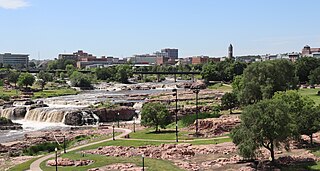
The Big Sioux River is a tributary of the Missouri River in eastern South Dakota and northwestern Iowa in the United States. It flows generally southwardly for 419 mi (674 km), and its watershed is 9,006 sq mi (23,330 km2). The United States Board on Geographic Names settled on "Big Sioux River" as the stream's name in 1931. The river was named after the Lakota people which was known by them as Tehankasandata, or Thick Wooded River.

Wilmot Wood Brookings was an American pioneer, frontier judge, and early South Dakotan politician. He was provisional governor of the Dakota Territory, and both the cities of Wilmot and Brookings as well as the county of Brookings, South Dakota are named for him.

Corson is an unincorporated community in Brandon Township, Minnehaha County, South Dakota, United States with a population of 70. It lies immediately north of Interstate 90 and Brandon on South Dakota Highway 11. Once mainly a railroad and farming community, it is becoming an industrial area supporting the county. Sioux Falls is located 12 miles (19 km) west-southwest of the community. It is served by the BNSF Railway Company.

Split Rock Creek State Park is a state park of Minnesota, USA, located in Ihlen, or just south of Pipestone.
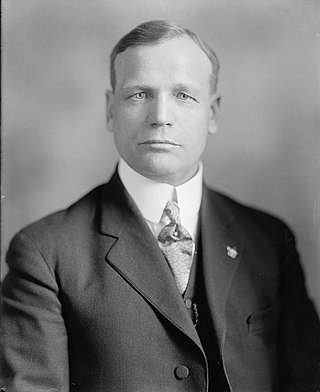
Charles Andrew Christopherson was an American lawyer and politician in South Dakota. He was elected to the state legislature in 1912. In 1918 he was elected to the United States House of Representatives, where he was re-elected to a total of seven terms until being defeated in 1932, during the Great Depression.
This article deals with the history of Sioux Falls, South Dakota.
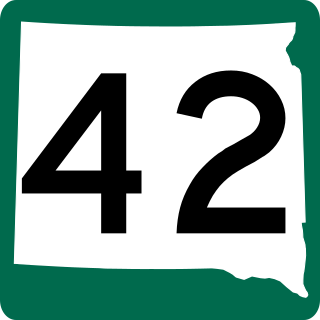
South Dakota Highway 42 (SD 42) is a segmented state highway in southeastern South Dakota, United States. The first segment is a six-mile-long (9.7 km) highway in Aurora County. The second and longest is 60 miles (97 km) long and connects Ethan and Sioux Falls. The final segment connects Sioux Falls to Iowa Highway 9 southeast of Rowena.

The Sioux Falls Metropolitan Statistical Area, as defined by the United States Census Bureau, is an area consisting of four counties in South Dakota, anchored by the city of Sioux Falls. The metro area is referred to locally as the Sioux Empire. Despite the name, it is considered a part of the larger area known as Siouxland as it is within the Big Sioux River basin. As of the 2020 census, the MSA had a population of 276,730.

The 2008 United States presidential election in South Dakota took place on November 4, 2008, and was part of the 2008 United States presidential election. Voters chose three representatives, or electors to the Electoral College, who voted for president and vice president.
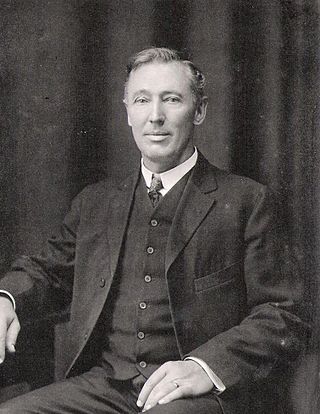
Joe Kirby was a self-educated son of Irish immigrants who became an important figure in South Dakota history. He helped shape South Dakota law in its formative years, started one of the preeminent law offices in the area in the late 19th and early 20th centuries where numerous future lawyers and judges got their start, founded Western Surety Company and participated in the creation of several other businesses.
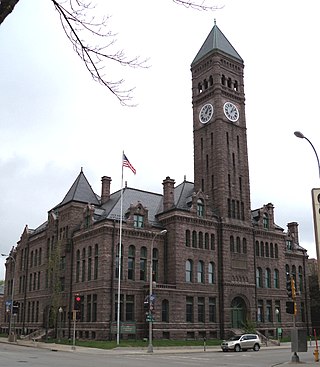
Wallace L. Dow (1844-1911), often known as W. L. Dow, was an architect of Sioux Falls, South Dakota. He has been referred to as the "Builder on the Prairie" and was "considered the premier architect of South Dakota in the late 19th century."

Sioux Kingsbury Grigsby was an attorney and politician in the United States state of South Dakota. Grigsby was born into a prominent pioneering family, Kingsbury family in South Dakota and set up a law practice which he would maintain for over 60 years. Grigsby served as state representative, state senator, and Lieutenant Governor of South Dakota from 1945 to 1949.
The following is a timeline of the history of the city of Sioux Falls, South Dakota, USA.
Steve Hickey is an American pastor and politician who served three terms in the South Dakota House of Representatives representing District 9, from 2011 to September 2015.
Harold Theodore Spitznagel was an American architect from South Dakota. Spitznagel was best known for residential and institutional architecture, including the original Mount Rushmore visitor center. His styles included Prairie School, Art Deco, and Moderne architecture. He graduated from the University of Pennsylvania, was posthumously inducted into the South Dakota Hall of Fame, and has been called the "foremost 20th-century architect" of the state of South Dakota.

Melvin Grigsby was an American attorney, politician, and military leader from South Dakota. A Union Army veteran of the American Civil War, Grigsby was most notable for his service as South Dakota Attorney General and an organizer and commander of the 3rd United States Volunteer Cavalry Regiment during the Spanish–American War.
Crystal Johnson is an attorney from South Dakota serving as State's Attorney for Minnehaha County, the state's most populous county, of which the county seat is Sioux Falls.















